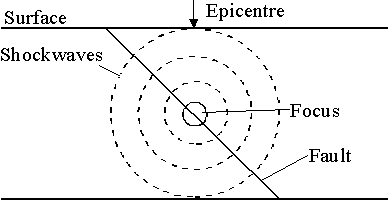Education Links
Leaving Cert
 Maths
Maths
 French
French
 English
English
 Chemistry
Chemistry
 Physics
Physics
 Biology
Biology
 Economics
Economics
 Spanish
Spanish
 Geography
Geography
 History
History
Junior Cert
Much of our understanding of earthquakes is based upon a revolutionary theory of earth dynamics, called PLATE TECTONICS.
3. Earthquakes
Movement along any fault rarely occurs as a smooth process; instead it tends to be 'jerky' with sudden abrupt movements followed by long periods where little happens. While the faults described here are huge in extent, there are in fact millions of smaller cracks that are found along the margins of plates and movement can occur along any one as the heat energy generated by the earth's interior is converted into movement of the earth's crust. Under great pressure movement occurs at a point of weakness along a fault and the shockwaves spread outward from this focus.
Terminology
- Seismograph: an instrument that measures movement in the earth's crust. These sensitive instruments will record any movement in the crust. When a truck passes nearby it will cause vibrations that will be recorded.
- Richter scale: this is the scale that is used to measure the power released by the quake when movement occurs along a fault. This scale is logarithmic so that an earthquake of magnitude 6 is one thousand times more powerful than one of magnitude 3. The recent earthquake in Turkey had a magnitude of 7.8, equivalent to over 6 hydrogen bombs.
- Epicentre: this is the point on the earth's surface directly above the breaking point or focus of the earthquake.


